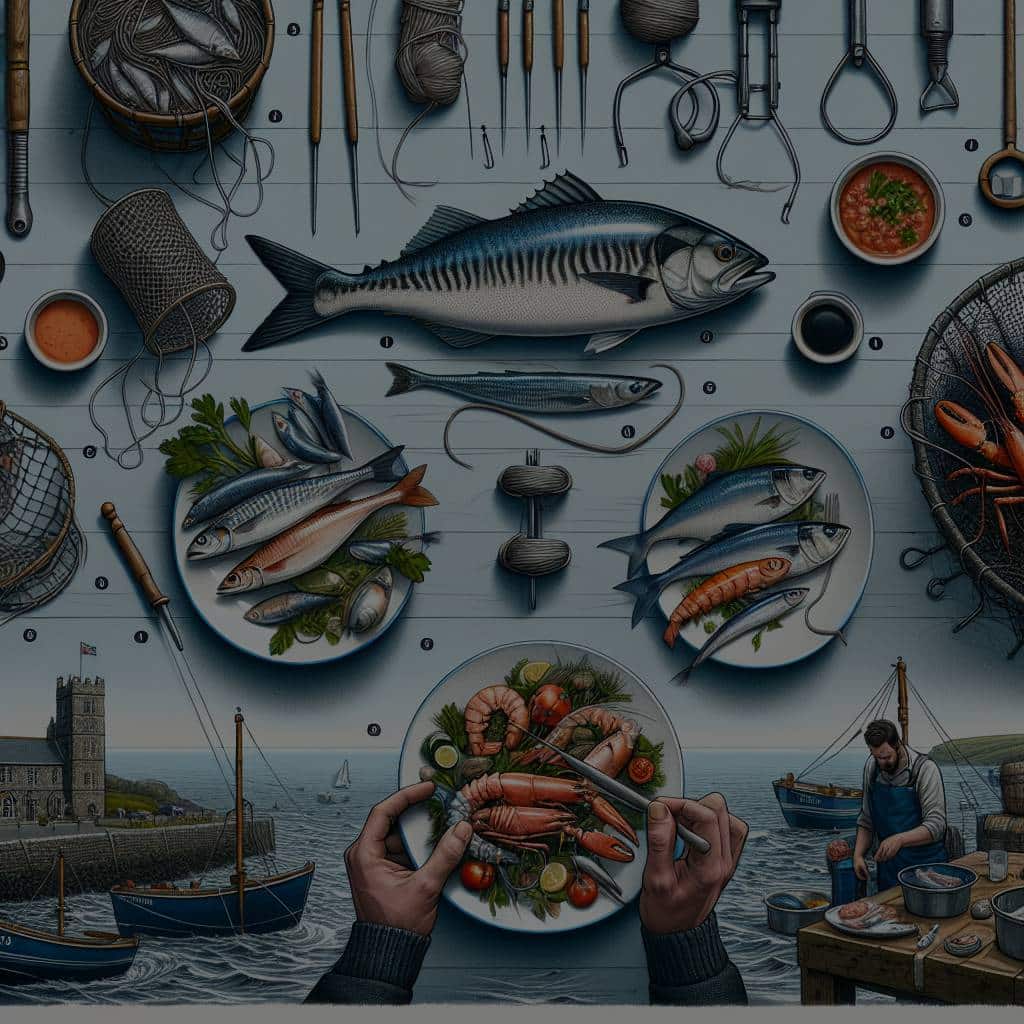How to Incorporate Sustainable Fishing Practices in UK’s Seafood Cuisine?

The UK’s rich maritime heritage and renowned seafood cuisine is a source of national pride, an engine for local economies, and a vital link in the global food chain. However, as you savour the succulent flavours of cod and chips or delight in the tangy aroma of a smoked salmon dish, have you ever paused to consider where your seafood comes from? In today’s era of heightened ecological awareness, issues such as overfishing, bycatch, and the impact of fishing methods on marine biodiversity have come into sharp focus. This article will guide you through the ways you can incorporate sustainable fishing practices into your seafood cuisine, to ensure the health of our oceans, marine species, and ultimately, the future of our planet.
Understanding the Importance of Sustainable Seafood
The crux of sustainable seafood lies in understanding its significance. It’s not just about the fish we eat today but the fish that will be available for future generations.
Dans le meme genre : How to Create an Inclusive Playground for Children with Disabilities in the UK?
Sustainability is a holistic concept that marries the need for food and protein with the imperative of maintaining the health of our marine ecosystems. It encompasses responsible fishing methods that limit the impact on the marine environment and prevent the depletion of fish stocks.
The marine food chain is complex and interconnected. Changes in one part of the system can have widespread effects. Overfishing of a particular species, for example, can lead to an imbalance in the ecosystem, affecting other species and the overall health of the marine environment. Similarly, certain fishing methods can be detrimental, causing unnecessary bycatch or damaging habitats.
A découvrir également : What’s the Latest on the UK’s High-Speed 2 (HS2) Railway Project?
Choosing the Right Fish: An Ode to Biodiversity
An essential aspect of sustainable seafood cuisine involves making informed choices about the types of fish you consume. Not all fish species are created equal in terms of their sustainability. Some are more resilient and can recover quickly from fishing pressures, while others are more vulnerable.
Take tuna, for example. It’s a favourite in many households and restaurants, and it’s also a rich source of protein and omega-3 fatty acids. But did you know that certain tuna species, such as the Atlantic bluefin, are severely overfished? Alternatives like albacore or skipjack tuna are more sustainable choices because they reproduce quickly and in large numbers.
Utilising a greater variety of seafood species also helps to distribute fishing pressure more evenly across different populations. This is where the beauty of biodiversity comes into play. By introducing lesser-known but equally delicious species into your cuisine, you can contribute to the sustainability of our fisheries.
Navigating Seafood Labels: The MSC Certification
When you’re shopping for seafood, how can you tell if it’s sustainably caught or farmed? One reliable way is to look for certifications such as the Marine Stewardship Council (MSC).
The MSC is an international non-profit organisation dedicated to promoting sustainable fishing practices. Seafood products bearing the MSC blue fish label have met stringent standards for sustainability. They come from fisheries that have robust management practices in place, minimise their environmental impact, and maintain healthy fish populations.
The MSC certification system is based on three core principles: sustainable fish stocks, minimising environmental impact, and effective fisheries management. So when you choose seafood with the MSC label, you can be assured that you are contributing to the sustainability of our oceans.
Leveraging Technology for Sustainable Seafood
The power of technology should not be underestimated in the quest for sustainable seafood. From tracking and traceability tools to Google-powered data platforms, technology is enabling greater transparency and more informed decision-making in the seafood supply chain.
For instance, the Global Fishing Watch, a partnership between Google, Oceana, and SkyTruth, uses satellite data and machine learning to monitor fishing activities worldwide. This tool helps to combat illegal fishing and promotes accountability in the seafood industry.
In the retail sector, technology is empowering consumers to make more sustainable choices. There are now various seafood guide apps available that provide detailed information about different fish species, including their sustainability status, nutritional profiles, and even recipes.
Climate Change and Sustainable Seafood
Our changing climate is having profound effects on our oceans and fisheries. Rising sea temperatures, ocean acidification, and shifts in ocean currents are impacting fish populations and their habitats.
Sustainable seafood isn’t just about managing our fisheries effectively; it’s also about mitigating climate change. The choices we make about our seafood can have both direct and indirect impacts on our climate.
By opting for sustainably caught or farmed seafood, we can help to reduce the carbon footprint of our food. Sustainable fishing methods are generally low-impact, meaning they use less fuel and emit fewer greenhouse gases. Additionally, sustainable seafood farming can sequester carbon and act as a buffer against ocean acidification.
While the challenge may seem daunting, the power to effect change lies in our hands—or on our plates, to be precise. By incorporating sustainable fishing practices into our seafood cuisine, we can savour the bounties of the sea while ensuring their continued existence for generations to come.
Adapting Your Seafood Consumption: Trade-offs and Choices
Incorporating sustainable practices into your seafood cuisine will inevitably involve making some trade-offs. Thankfully, with a bit of knowledge and foresight, these trade-offs can become empowering choices that contribute to the wellbeing of our marine ecosystems.
The first trade-off involves the choice between wild-caught and farmed seafood. Both have their pros and cons. Wild-caught seafood can often be more sustainable, if the fish stocks are healthy and the fishing practices are responsible. However, overfishing can deplete wild populations and damage habitats. On the other hand, well-managed aquaculture can produce seafood sustainably, but poor farming practices can cause pollution and other environmental issues.
The key is to make informed decisions. Look out for the MSC certification on wild-caught seafood and the Aquaculture Stewardship Council (ASC) certification on farmed seafood. These labels guarantee that the seafood has met stringent sustainability standards.
Another trade-off lies in the choice of species. As indicated earlier, some species are more resilient than others. Make a point of learning about different fish species and their sustainability status. Consult a good fish guide or use a seafood guide app. These resources can help you make informed choices about your seafood consumption, promoting overall seafood sustainability.
The Role of Legislation: UK’s Fisheries Bill
A major driver of sustainable fishing practices in the UK is the Fisheries Bill. Passed into law in 2020, the bill sets the framework for UK’s fishing activities post-Brexit. It underlines the commitment to sustainable fishing and marine conservation, and it includes provisions for science-based fisheries management.
The bill marks a shift towards a more sustainable approach to fishing. It sets out measures to rebuild overfished stocks, reduce bycatch, minimise damage to marine habitats, and ban supertrawlers from marine protected areas.
As consumers, we can support these legislative efforts for sustainable fishing by prioritising seafood that comes from fisheries complying with the bill’s provisions.
Conclusion: Your Plate, Your Planet
Incorporating sustainable fishing practices into our seafood cuisine is not a mere dietary shift – it is a positive lifestyle change that can impact the health of our oceans and the future of our planet. By understanding the importance of sustainable seafood, making informed choices, recognising credible certifications like the MSC, embracing technology, and supporting legislative efforts for sustainable fisheries management, we can cast a vote for marine conservation every time we sit down to enjoy a seafood meal.
Our changing climate, the condition of fish stocks in our seas, and the practices on the high seas are all interconnected. We cannot ignore one aspect without affecting the others. So, let’s make conscious choices – choose sustainably caught or farmed seafood, try out different species to celebrate biodiversity, and leverage the power of technology and legislation to ensure that our favourite seafood dishes can be savoured by generations to come.
After all, when it comes to sustainable seafood cuisine, we’re not just talking about fish – we’re talking about the lifeblood of our oceans and the wellbeing of our planet. So next time you’re about to enjoy a fish dish, remember – your plate, your planet.
